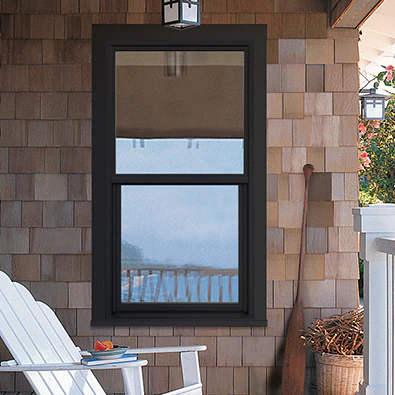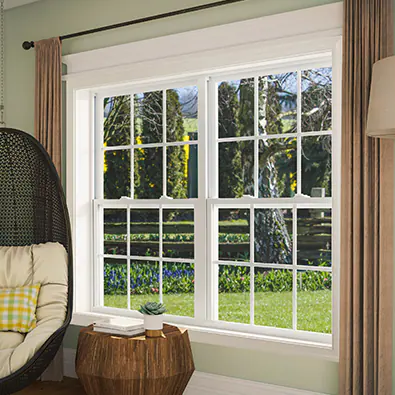Windows are a crucial part of your home’s structure. They keep your home appropriately insulated, ventilated and safe. Two common types of windows are casement and sliding windows. They each come with their own pros and cons. Here’s what you need to know about casement vs. sliding windows.

Table of Contents
Casement Windows
Casement windows, also known as crank windows, swing open like a door. Casement windows are attached to one side of the frame with hinges. They can open wide, letting in lots of air and light. Casement windows don’t leave any bars or frames in the center of the window opening, giving a clear view outside. They are commonly used in living rooms, bedrooms, and hallways. Casement windows have strong locks and seal tightly.

Casement windows can be installed to open inwards or outwards. They are available in a variety of materials and designs. Wood is the most commonly used material for casement windows, but you can get them in PCV, vinyl, fiberglass or aluminum as well. Casement windows are available as single frames or double frames.
Sliding Windows
Sliding windows open by sliding one part of the windowpane to the side. They are a relatively newer design, offering a more modern look. They are easier to shut and open, even if the window is higher up. If the opening for your window is wider than it is tall, a sliding window will be a good match. The sliding window has two or more sashes that sit behind one another when opened. For this reason, a sliding window can’t be fully opened as there will always be a part of the window blocking one side. But this isn’t usually a problem in wider window frames.

Sliding frames are made from materials like PVC or aluminum as wood is too bulky to slide across the frame. Since sliding frames don’t open inwards or outwards, there is no risk of accidentally knocking into a window. This is why sliding windows are often used for tight spaces like small kitchens or bathrooms.
Casement vs Sliding Windows: Pros and Cons
Casement windows
Pros:
- They seal tightly, which is great for insulation. Your home can easily maintain a comfortable temperature regardless of outside weather, helping you save energy.
- They can fully open, making them an ideal choice for spaces like living rooms and sunrooms, maximizing natural light and allowing you to enjoy expansive views.
- You can comfortably reach behind the window pane making them easy to clean.
- Typically more secure, with the option of multiple locking points available.
- They can also serve as emergency exits.
Cons:
- Require regular maintenance as wood can warp over time and hinges need oiling.
- They can be a safety hazard when left open.
- They can be a bigger investment, especially customized sizes and designs.
Sliding windows
Pros:
- More affordable option given the simplicity of design.
- Easy to operate, requiring less force as there is a track to guide the panel.
- Less likely to cause any accidents as they don’t swing open.
- Available in a range of options for sizing and can be used for much wider openings.
Cons:
- Air gaps between the sliding frames make them less energy efficient.
- Exteriors can be difficult to clean as you may not be able to reach the back, especially at heights.
When to Choose Casement Windows
Casement windows are best for rooms that need lots of air, like kitchens and bathrooms. Their ability to fully open allows maximum air circulation, helping to remove odors and steam effectively. For spacious rooms with enough clearance around the windows, these can be a great choice. Their outward swinging design requires sufficient space to fully open without obstructing pathways or furniture placement.
Casement windows are very customizable, so consider them for areas like the front of the home for that extra curb appeal. Apart from the size and material, you can choose from a variety of colors and finishes. Decorative handles and grilles also add to the appeal.
When to Choose Sliding Windows
Sliding windows are an excellent option for rooms or areas that have limited space around the window openings. In high-rise buildings or areas prone to high winds, sliding windows are usually the safer choice. Their design prevents them from catching winds that could potentially blow open a projecting casement window.
When you have the luxury of a wide window opening or a broad space, a casement window could become heavy to operate. Sliding window allows you to have an expansive glass area while still providing an easy opening. Since they simply glide horizontally, even large sliding windows can be easily opened and closed.
Casement vs Sliding Windows: The Final Verdict
Still not sure which window is the best for you? Consider these things when picking a window between them:
- Energy Efficiency: While casement windows have overall better insulation, modern sliding windows have been designed with minimal gaps, enhancing their energy efficiency.
- Weather Performance: Casement windows have a tighter seal and perform well in all weather conditions. Sliding windows are not as tight but they are waterproof.
- Security: Both sliding and casement windows are secure. Check that the windows you purchase have strong frames and locks.
- Space: Think about how big the opening is, how high it is above the ground and how much room you have to open the window.
- Airflow: Decide how much fresh air you need for ventilation. Sliding windows open partially while casement windows open fully.
- Cost: Sliding windows usually cost less than casement windows but cost can depend on the size of the window and materials used.
- Design: Look for windows that match with your home’s décor. Both casement and sliding windows suit traditional and modern décor.
- Maintenance: Think about how easy it is to clean and take care of the windows. The location of the window also determines cleaning feasibility. Also, you should consider ease of replacement if need be. If the window is in a tight space or has obstacles around it, a sliding window might be a touch easier to replace. If the old window is damaged and needs extra effort to take out, a casement window might be slightly easier because the entire sash detaches from the frame.
By understanding the differences between casement and sliding windows, you can choose the best ones for your home. Think about all these factors to make sure your windows make your home comfortable, look good and save energy.
Single Hung vs. Double Hung Windows
If you are looking to replace your windows and give your home a new look, there are certain factors to consider. One of them is choosing between single-hung and double-hung windows. Read on and learn their key differences, pros and cons to make the right choice.

Difference Between Single-Hung and Double-Hung Windows
What is a Single-Hung Window?
A single-hung or single-sash window has one movable sash. While the upper sash remains fixed, its bottom sash can slide up or down.

Single-hung windows have frames made using various materials, like wood, aluminum, vinyl and fiberglass. They can also be customized based on your preferences and design needs.
How Do Single-Hung Windows Work?

Single-hung windows are easy to operate. To open such a window, simply lift the bottom sash upward. Its vertical sliding movement allows control over the ventilation and airflow that enter the room. The fixed top sash provides security and stability. Its simple operation reduces the chance of mechanical failure.
Benefits of Single-Hung Windows
The perks of single-hung windows include:
- Cost-efficient: These windows have less moving parts, are easier to manufacture and are made using affordable materials.
- Energy efficient: These windows often come with double glazing, low-emissivity coating and even insulated frames which allows minimal heat transfer and optimum energy efficiency.
- Easy installation: These windows do not require operable parts which makes them easy to install.
Drawbacks of Single-Hung Windows
The downsides of single-hung windows include:
- Difficult to clean on upper floors: Cleaning the bottom sash is relatively easier but washing the top half can be challenging. To clean the exteriors of such windows, you will have to either stick your head out or go outside. This makes it difficult to clean the window, especially on upper floors.
- Difficult to repair: If the upper sash of such windows break, you will need to call a professional and get the entire window replaced.
- Unsafe for kids: They can easily climb out the window by opening the bottom sash.
- Less ventilation: Single-hung windows open only at the bottom, decreasing the airflow and ventilation in the room.
What is a Double-Hung Window?

A double-hung window has two movable sashes, both of which can slide up or down. This allows proper airflow and ventilation inside the room. These windows come in aluminum, fiberglass, wood and vinyl frames. You can also select double-hung windows in various styles, colors and materials.
How Do Double-Hung Windows Work?

Double-hung windows come with two movable sashes. Both slide up or down independently. The hot air moves out of the upper sash while the cool air comes in via the bottom sash. This introduces a healthy airflow exchange in the room.
Benefits of Double-Hung Windows
The perks of double-hung windows include:
- Better ventilation: These windows allow better airflow and ventilation from both top and bottom sashes.
- Easy cleaning: These windows have moveable parts which makes cleaning from both outside and inside relatively easy.
- Safe for kids: These windows can have the top sash open for ventilation and bottom sash locked, ensuring the kids don’t climb out.
Drawbacks of Double-Hung Windows
The downsides of double-hung windows include:
- Less energy-efficient: Both the sashes of these windows can open which increases the chance of air leaks, making them less energy-efficient.
- Costs more: Both the purchase and installation of double-hung windows costs more.
- More maintenance requirements: The hardware of these windows can wear out over time, which makes it crucial for you to clean and dust them regularly.
Single-Hung vs. Double-Hung Windows: A Straightforward Comparison
Both, single and double-hung windows come with perks and downsides. Here’s a direct comparison for you to make the right choice.

Choose Right
Choosing the type of window involves considering factors such as budget, personal preference, maintenance levels, energy efficiency and kids’ safety. Depending on your priorities and family members, you can choose one between single-hung and double-hung windows. For a home with kids and need for better ventilation, a double-hung window makes the right choice. A home that needs more energy efficiency can have a single-hung window installation.


2 thoughts on “Casement Windows vs. Sliding Windows & Single Hung vs. Double Hung Windows”